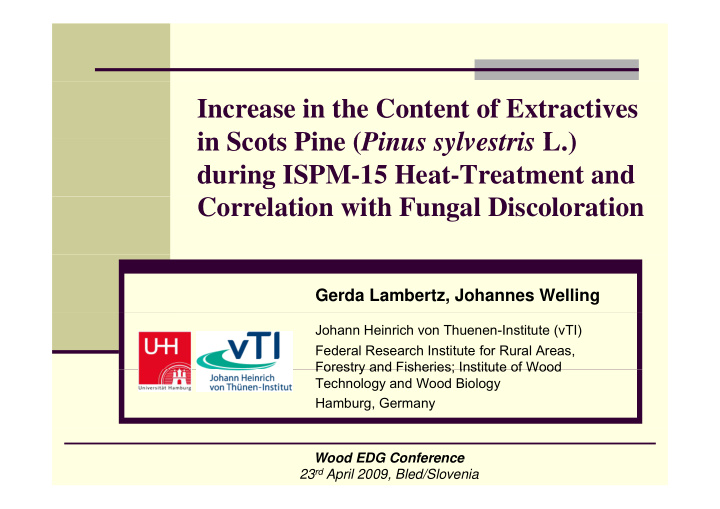



Increase in the Content of Extractives in Scots Pine ( Pinus sylvestris L ) in Scots Pine ( Pinus sylvestris L.) during ISPM-15 Heat-Treatment and Correlation with Fungal Discoloration Gerda Lambertz, Johannes Welling Johann Heinrich von Thuenen-Institute (vTI) Federal Research Institute for Rural Areas, Forestry and Fisheries; Institute of Wood Forestry and Fisheries; Institute of Wood Technology and Wood Biology Hamburg, Germany Wood EDG Conference 23 rd April 2009, Bled/Slovenia
Topics p Fundamentals I. Background Problems Problems Research II. Cause of fungal infestation Scientific approach Results III. Effective measures to avoid infestation Temporary active preservatives vs kiln drying ? T ti ti kil d i ? Outlook IV. Wood EDG Conference 23 rd April 2009, Bled/Slovenia G. Lambertz 2
Facts � Wood packaging material: ntals � freshly cut, undried sawn timber (in Germany: mostly Scots Pine) damen � l � low quality lit � low-priced and disposable just in time Fund � complete kiln-drying is often too expensive � f � free of conventional chemical wood preservatives f ti l h i l d ti I. � must be phytosanitary treated before exporting (ISPM No 15) Wood EDG Conference 23 rd April 2009, Bled/Slovenia G. Lambertz 3
ISPM No15 � 2002 IPPC adopted ISPM Nr.15: ntals � to avoid the spreading of quarantine harmful organisms (insects) (insects) damen � in more than 40 non-European countries required Fund � treatment only in certified companies � treated material must be marked immediatly � treated material must be marked immediatly I. � two approved measures for phytosantitary treatment: Methyl bromid fumigation Heat-treatment Wood EDG Conference 23 rd April 2009, Bled/Slovenia G. Lambertz 4
Adopted measures p � Methyl bromid fumigation [MB] � not allowed anymore in most European countries ntals damen � „Heat-treatment“ [HT] � min 56°C for at least 30 minutes core temperature � min. 56 C for at least 30 minutes core temperature Fund � carried out in ordinary kilns I. � can be combinded with drying operations � no requirements regarding moisture content therefore � no requirements regarding moisture content, therefore minimized length of stay in the kiln (MC before HT ~ MC after HT) Wood EDG Conference 23 rd April 2009, Bled/Slovenia G. Lambertz 5
Problem � Fresh, heat-treated and undried sapwood shows a much higher affinity towards mould and blue stain ntals than normal material damen � visual defect � hygenical problem � hygenical problem Fund I. Remember: Remember: - complete kiln-drying is often too expensive - no conventional chemical wood preservatives Wood EDG Conference 23 rd April 2009, Bled/Slovenia G. Lambertz 6
Fungal infestation after one week g h earch I. Res II Control Control HT HT Wood EDG Conference 23 rd April 2009, Bled/Slovenia G. Lambertz 7
Fungal infestation after two weeks g h earch I. Res II Control Control HT HT Wood EDG Conference 23 rd April 2009, Bled/Slovenia G. Lambertz 8
Objectives j � Inhibition of fungal growth on non-dried heat treated wood and green wood until it has dried sufficiently h earch � Alternatives to conventional preservatives and kiln drying should be: y g I. Res � ecologically harmless � � economically advantageous i ll d t II � temporarily effective Wood EDG Conference 23 rd April 2009, Bled/Slovenia G. Lambertz 9
Scientific procedure p � Chemical analysis → Reason for increasing fungal risk h earch � Based on analytical results y I. Res → I dentification of low-cost methods to minimize the p problem by providing temporary protection against y p g p y p g II discoloring fungi Wood EDG Conference 23 rd April 2009, Bled/Slovenia G. Lambertz 10
Chemical analysis y Att ib t Attribute HT HT : Control C t l Moisture content No significant difference sults Moisture distribution No significant difference II. Res pH-value Significant difference Free sugar content at surface Free sugar content at surface Significant difference Significant difference II Amount of lipophilic extractives Significant difference Wood EDG Conference 23 rd April 2009, Bled/Slovenia G. Lambertz 11
Explanation p � Lipophilic extractives (fats, fatty acids, triglycerides) as well as free sugars are an important foodstuff for wood discoloring fungi sults Heat treatment II. Res Release of extractives in parenchyma cells Release of extractives in parenchyma cells II additional nutrition source Wood EDG Conference 23 rd April 2009, Bled/Slovenia G. Lambertz 12
Idea � chemical bonding of lipophilic extractives � to withdraw foodstuff Saponification Saponification sults � change of surface conditions g II. Res � to inhibit germination of fungal spores II I Increase of ph-value f h l Alkali-treatment Wood EDG Conference 23 rd April 2009, Bled/Slovenia G. Lambertz 13
Fungal infestation after three weeks (HT) g sults II. Res II No treatment with No treatment with Caustic soda 7,5% + Caustic soda 7,5% chemicals surfactant Wood EDG Conference 23 rd April 2009, Bled/Slovenia G. Lambertz 14
Temporary treatment vs kiln drying p y y g Alkalization Kiln drying Costs of treatment ++ - sults II. Res Duration of treatment D ti f t t t + + - Effectiveness + ++ II Duration of effectiveness - ++ Wood EDG Conference 23 rd April 2009, Bled/Slovenia G. Lambertz 15
Conclusion Alkalization of fresh sapwood as a first and temporary protection p y p tlook + Drying (either natural or technical) as a Drying (either natural or technical) as a V. Out long- term protection IV = Optimal protection against mould and blue stain Wood EDG Conference 23 rd April 2009, Bled/Slovenia G. Lambertz 16
Wood EDG Conference 23 rd April 2009, Bled/Slovenia G. Lambertz 17
Recommend
More recommend